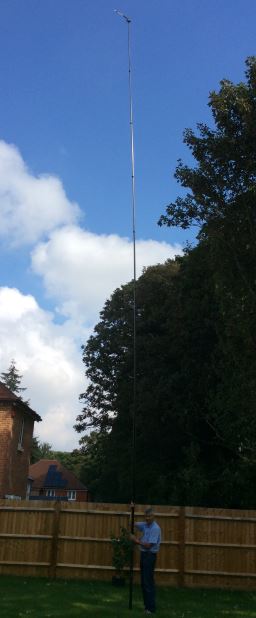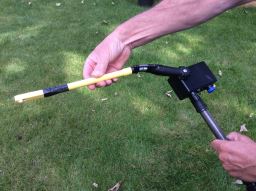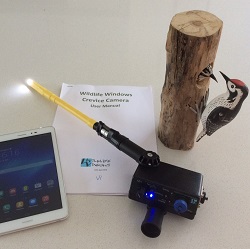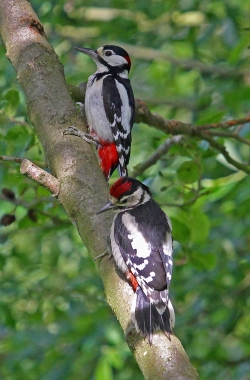Lesser spotted woodpeckers – information about the birds and our project
Each spring we want as many people as possible to find and record Lesser Spot and if possible find their nests and record the breeding outcome. The aim of the Woodpecker Network citizen science project is for us all to work together to collect as much data as possible about the birds each year. As last year Gus Robin will be co-ordinating for LesserSpotNet in the South West and Ken and Linda Smith in the rest of the country.
Male Lesser Spots have a red crown, but so do young Great Spots (unlike the alults) and this causes lots of confusion, especially in June and July. If you are not sure if your Woodpecker is a Great Spot or a Lesser Spot - here is how to tell the difference.
Spring 2025, please prepare to look out for Lesser Spots, they will be calling and drumming from mid-February onwards and are visible before the leaves open on the trees. See the latest news for progress so far in finding Lesser Spots and their nests this spring. Follow us on BlueSky @LesserSpotNet.bsky.social
Any Lesser Spot found calling or drumming in February - April will be attempting to nest in that area, If you find one please record the date and location and submit the record to your county bird club recorder or to BTO Birdtrack. We would love to hear about it too send the information to Woodpecker Network via our website email.
See below for advice and guidance on how to find breeding Lesser Spots or download our guidance note.
Ken Smith's talk on The Joys and Challenges of Monitoring Lesser Spotted Woodpeckers for the Rare Breeding Bird Panel on 16 March 2023 is still available on RBBP's uTube website, Talk 10 The joys and challenges of monitoring Lesser Spotted Woodpeckers it lasts 15 minutes.
2024 - The project to find and monitor nests of Lesser Spotted Woodpeckers continued in 2024 and LesserSpotNet volunteers found and monitored eleven nests. Read and download the full report here Lesser Spotted Woodpeckers in 2024 Report
In 2019, our best year ever, woodpecker-network volunteers found and monitored 23 nests across 9 counties, with 12 nests found in the New Forest. This is definitely the place to go if you want to see Lesser Spots. The yearly reports of all the work of the Network since 2015 are posted on the news page (right hand column). We outline below the aims of the project and how you can get involved.
Finding breeding Lesser Spotted Woodpeckers
Lesser Spotted Woodpeckers are a challenge to all our birdwatching skills. They are pretty much invisible for most of the year and only in February and March do they call and drum with any regularity. Once they have settled on a nest site by mid-April they are very inconspicuous and secretive until they are feeding young in late May.
They can be found nesting in any woodland but seem to be more abundant in well wooded areas and woods with high levels of dead wood or woods associated with wetlands. They often nest near the edges of woodland or in woodland fringes. The best bet for finding breeding birds is to check out past sites. The birds seem very site faithful so often turn up in traditional sites over many years. Drumming and displaying drops off rapidly through the day so early morning visits seem to be best.
In general, the Lesser Spot drum is much softer and for a longer duration than Great Spot and seems to tail off at the end rather than ending with a flourish. But it is still possible to be confused by a soft drumming Great Spot. With patience, you can get to see the bird to confirm identity. You can find examples of Lesser Spot calls and drumming on the xeno-canto website look for recordings made in England or western Europe.
Finding the nest
The next and probably the biggest challenge is to find the nest. There are a few tricks to help you with this but there is no substitute for persistence. If you find the birds calling, drumming or displaying in an area of woodland there is a good chance they will nest in the vicinity.
Lesser Spotted Woodpecker nests are almost always in dead trees or dead limbs on live trees. So in March, before the leaves appear, have a thorough check around the displaying area and note any potential nest sites to be visited later. They particularly like dead alder, willow, birch, poplar, sycamore and beech but other species can be used.
In most years all the nests found were close (within 10 metres) to a stream or pond, so this seems to be important.
Then from April onwards make regular checks of these sites looking for birds, or any signs of nest excavation such as woodchips on the ground beneath the tree. Although it won’t help you in your first year our most successful strategy is to make a point of always visiting last year’s nest site. They frequently excavate in the same tree and have even been known to re-use the nest cavity itself.
The Lesser Spot nest hole is small, about 30mm diameter, for comparison a Great Spot nest hole is 50mm and Green Woodpecker, 70mm.
[Lesser Spot just over an inch, Great Spot about 2 inches, Green nearly 3 inches in diameter].
Recording breeding success - we can help you
For most birdwatchers recording the contents of Lesser Spotted Woodpecker nests is simply not possible. By using video nest inspection cameras we make this possible. Volunteers with nest hole inspection cameras are Ken and Linda in West Sussex, Gus Robin in Somerset and Mat Shore in Norfolk. They may be able to visit the nest site with you to help monitor a nest, but otherwise, please record the information set out below.
If you find a nest …
If you find a nest, please contact us as soon as possible so we can discuss how best to monitor it and whether it is appropriate to look inside the nest with the video nest inspection camera.
Please keep a note of the date and time of your observations, the exact location and the species of tree and if you can, the height of the nest. Please record the behaviour of the adults at the nest.
Even without the nest inspection camera it is possible to work out the stage of the nesting cycle from the behaviour of the adult birds at the nest.
- During excavation, the bird will be seen excavating a cavity but only when it is deep inside emerging head first to throw out woodchips is the cavity anywhere near complete. Lesser Spots usually make a new cavity each year but often return to the same small area of woodland or the same dead tree if it is still standing. Birds often try an excavation but move on elsewhere before completing a cavity. This may be an important aspect of breeding so please record such failed cavities.
- During laying and incubation the birds become very secretive and only change over every two hours or so - at this stage it is easy to assume the nest is no longer active. It is worth being patient and waiting to confirm that the nest is still active if you have the time available, or return regularly to increase the chance of detecting activity.
- During chick rearing the young are fed every 5-10 minutes and their age can be worked out from the adult behaviour. For the first week after hatching the young are always brooded by one of the adults so there is a changeover every time the young are fed. The young are usually fed inside the cavity until their last week when they can be fed at the nest hole with the adults only going in occasionally. For their last 2-3 days in the nest the young can be quite noisy making insistent begging calls (but not always) and can often be seen looking out of the nest hole waiting to be fed.
- Please take photographs, where appropriate, and take care not to disturb the birds.
- We are particularly interested in the food being brought for the young, for example, caterpillars or aphids. If these can be seen in photos so much the better.
We will treat all records in complete confidence and will not publish any details of nest sites. The nest records will be treated as confidential by the BTO.
Nest inspection cameras
We have developed and refined the nest inspection cameras over the last 15 years and they are now very simple to use and effective. They consist of a miniature video camera (like the ones incorporated in your mobile phone) and an array of light emitting diodes built into a probe which can look through the entrance hole into the nest cavity looking down to view the contents. The video images are sent by wi-fi to an iphone or ipad where they can be viewed and recorded. Currently we use commercial units supplied by a small UK company Wildlife Windows.
The video probe is mounted atop a set of telescopic poles which allow it to look into nest cavities up to 18-20m above the ground. The whole inspection process takes a few minutes and the disturbance to the birds is so low that we have never seen any adverse impacts.
The arrangements are quite straight forward. If you find a Lesser Spotted Woodpecker nest, let us know and we or one of the other LesserSpotNet volunteers will arrange to visit with a nest inspection video camera to check the eggs or young. We have four video systems available and, depending on demand, after the first visit we can leave one with the nest finder to monitor the nest contents regularly until the young fledge.
We have developed the nest viewing cameras over the last 15 years, initially to check out Great Spotted Woodpecker nests but as the technology has improved we have been able to monitor Lesser Spots too. The nest inspection is done from the ground with the camera on a long telescopic pole which can reach up to 60 feet above the ground and only takes a few minutes. The images can be viewed and stored on an ipad or iphone. In visiting well over 1000 Great Spot and 60 Lesser Spot nests we have found no adverse impacts whatsoever on the birds.
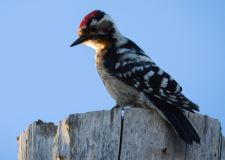
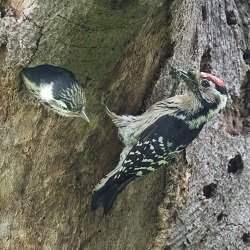 Male Lesser Spotted Woodpecker feeding young © Julie Redford
Male Lesser Spotted Woodpecker feeding young © Julie Redford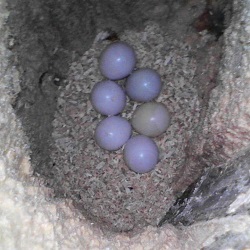 Lesser Spotted Woodpecker nest with 6 eggs © Ken and Linda Smith
Lesser Spotted Woodpecker nest with 6 eggs © Ken and Linda Smith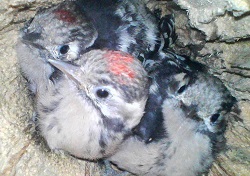 Lesser Spotted Woodpecker nest with three young, two males and a female © Ken and Linda Smith
Lesser Spotted Woodpecker nest with three young, two males and a female © Ken and Linda Smith